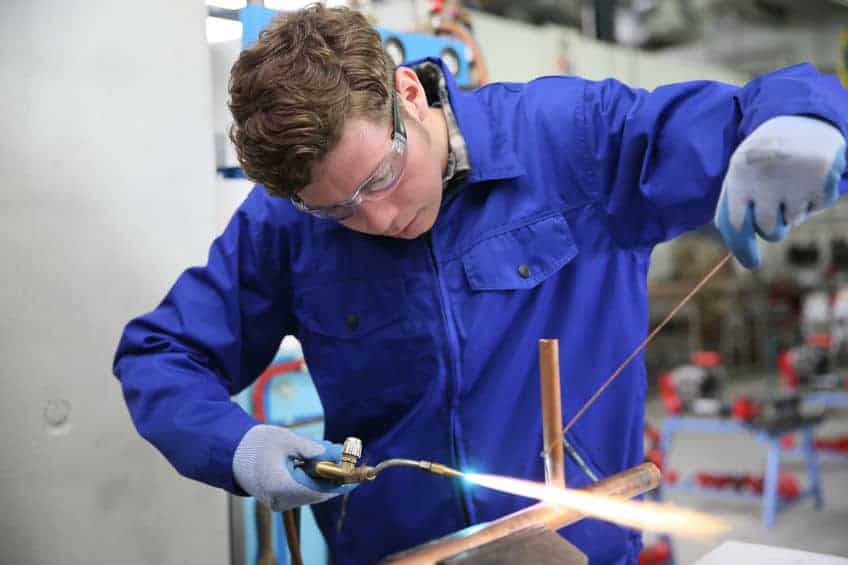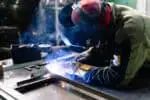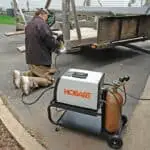Copper is an easy metal to be welded if you know the correct procedures to weld it.
While brazing and soldering are suggested to be the easiest ways to weld thin sheets of copper or copper pipes, however, these procedures can’t be applied to thick sheets of copper.
This is because copper gets heated up too quickly and spreads the heat too fast. Therefore, pre-heating of copper and high amperage of 400 amps is required to weld thick sheets of copper.
For this, the most ideal procedure is TIG welding copper!
Now, TIG welding copper will be smooth only if you choose the correct equipment for the process. Like, it needs separate electrodes and rods, shielding gases, and various other tools!
Don’t confuse the electrode with the rods in TIG welding! The rods used in TIG welding copper are deoxidized copper TIG rods, silicon-bronze rods and rods that are made of the raw base metals that is by taking out 1/8” of thin strips from the parent copper.
Just like the rods, there are specific electrodes and shielding gases that are to be used to TIG weld copper and in this article, I am going to tell you all about them. Also, I will explain you all the steps to TIG weld copper and the other miscellaneous items that you might be requiring while TIG welding!
So, without wasting a moment, let’s get started!….
Can you weld copper with TIG?
Yes, you can obviously TIG weld copper, about which I will tell you in details below. But remember, that TIG welding copper comes with different disadvantages and the very first one is that copper acts as a heat sink in this.
This means that copper is very conductive and will get heated up too quickly, for which the welds have to be too hot and have to be worked with too quickly. The end result will be that the thin base will warp and change its shape.
However, with the use of correct steps and equipment, you can successfully TIG weld copper and deliver good quality welds.
So, let’s now learn about them….
How to TIG Weld Copper?
TIG welding copper is not that tough if you know the correct steps for it:
1.) Getting the electrodes ready:
The first and foremost thing that you need to do for TIG welding copper is preparing the electrodes because copper needs sharp electrodes to be welded.
You can do it with the help of an electron grinded easily and in case if you do not have one, you can sharpen the electrodes with the help of a bench grinder as well.
Once, you have sharpened the electrodes, put it into the collet and then adjust the gas flow according to your needs.
2.) Setting up the welder:
Now, copper requires high amount of heat to be welded, somewhere around 350 amps for thick sheets of copper. Therefore, you need to have a big welder with high amperages for welding copper and adjust the heat settings accordingly.
After setting the amperage, the next step is to connect the return clamp from the welder in to the workpiece. This step will set up the circuit for the electricity flow.
Also, remember to check the grounding because copper is a really conductive metal and any fault in the grounding, any loose connection can make you receive a huge electric shock while the welding.
3.) Pre-cleaning of the copper:
Pre-cleaning of the copper is necessary before the welding because the weld will not hold on the surface of the copper if there are any contaminants or oxidized layers on the surface of the copper.
The best way to clean copper is to use a citrus-based degreaser. You can also clean off the oxidized layer with a stainless-steel brush and then make use of acetone, lacquer thinner or ethyl ketone for the same purpose.
Just make sure that the copper is free of any dirt and contaminants before you begin the welding.
4.) Putting away all the flammable solvents:
While the cleaning of the copper, it is evident that you might have used some flammable solvents.
Now is the time that you wash them away from the surface of the copper with the help of water and also make sure to keep the solvent bottles away from the site of the welding as welding copper needs high heat and the heat can ignite the solvents and cause massive flames, enough to cause burns.
5.) Checking the ventilation:
The fumes that are produced while welding of copper are toxic in nature and therefore, it is suggested that you open all the doors and windows and allow enough ventilation in the room before you begin to TIG weld copper.
Also, the high heat produced while the welding can suffocate you and cause discomfort.
6.) Wearing essential PPE for safety measures:
To save yourself from the fumes, flames, heat and toxic gases, it is a must for you to wear PPE such as respirators, masks, face shields, helmets, fire resistant gloves, EH rated boots, safety vests that are heat and flame resistant and also safety glasses that are anti-fog.
7.) Pre-heating the copper:
Copper spreads heat quite fast and therefore, it becomes hard to maintain a weld puddle. Therefore, if you are welding a coppers sheet, it is suggested that you pre-heat the copper sheet to a temperature between 400 to 700 degrees. This will help the copper to stay hot and aid in welding easily.
You can heat the copper using a propane torch. Blow the torch throughout the metal to heat the piece of copper evenly.
8.) Welding the joints:
Now is the time to put all the pieces to be joined together in a secured point. Then begins the actual action that is you have to press the pedal in order to start the spark in the electrode.
Remember to hold the electrode an inch away from the joint and hold the arc at 70 degrees to the copper surface that is to be welded.
Ignite an arc and push the rod in to form the puddle. Once the puddle is ready, spread the beads down the joint using the tip of the rod. Remember to maintain a steady rate of the arc while feeding the rod and spreading the pool. Continue to maintain the same pace while the entire welding procedure.
One point to note is that you have to work really fast with copper otherwise copper can cool down too quickly as it absorbs heat too fast. In case you work slow, the puddle will be lost and you will have to again start with a new arc.
9.) Post-cooling of the copper should be slow:
If copper will cool down too quickly, it might form cracks in the weld. Therefore, you need to take steps in order to let copper to cool really slow. Things that can help with slow cooling of copper post welding are: emerging copper in sand and covering it with fiberglass blanket.
What rod do you use to TIG weld copper?
Do not mix, electrode with rods in TIG welding. They are two separate entities. While the electrode is used to strike the arc, the rod is fed with the other hand to create the puddle and to create the weld.
The following different types of rods are used to TIG weld copper:
In case of use in high-end jobs:
For this, deoxidized copper TIG rods are being used. They are made specifically for the purpose of TIG welding copper. Following are the advantages of these types of rods:
-
-
- They provide cleaner and attractive welds
- They provide stronger welds
- The welds so produced will be of the same color as that of copper
-
In case you require stronger welds:
For this, silicon-bronze rods are being used. These rods are used to join copper to copper, and copper to steel or iron. Following are the advantages of these types of rods:
-
-
- They create welds that are very strong and durable
- They are less expensive than the former ones
- They are used to join copper to other metals too
-
In case you want exact look alike welds of copper:
For this, you can use 1/8” strips of copper as rods for TIG welding copper. Following are the advantages of these types of rods:
-
-
- The welds will look as if they are part of the original copper
- There will no difference in the composition of the base metal and the weld
- No separate rods have to be bought
-
You can also TIG weld copper with the Romex wires that are readily available at any local electric stores. But you can only make use of it while welding thin sheets of copper.
What electrodes do you use to TIG weld copper?/ What tungsten do you use for copper?
For TIG welding copper, you need electrodes that give out excellent sparks. Remember, the electrode in TIG welding is used only to start the arc and not to create the weld. You can make use of the following electrodes:
-
-
- Gold tip: 1.5% lanthanated tungsten
- Blue tip: 2% lanthanated tungsten
- Red tip: thoriated tungsten
- Grey tip: ceriated tungsten
- Purple tip: rare earth mix
-
What current do you use to weld copper?
The current required to weld copper depends on the thickness of the copper. The following chart will help you to learn about the relation between the thickness of copper and the amount of current that should be used:
| Thickness of copper in (mm) | Amount of current used (amps) |
| 1.0 mm | 20 to 60 amps |
| 1.0 to 2.0 mm | 50 to 160 amps |
| 2.0 to 5.0 mm | 120 to 300 amps |
| 6.0 to 10.0 mm | 250 to 375 amps |
| 12.5 mm | 350 to 420 amps |
| 15.0 mm | 400 to 470 amps |
To which temperature should copper be pre-heated in TIG welding?
The following table will tell you that the pre-heat temperature of copper depends on the thickness of the base metal:
| Thickness of copper in (mm) | Pre-heat temperature (degree C) |
| 1.0 mm | >10 |
| 1.0 to 2.0 mm | >10 |
| 2.0 to 5.0 mm | 50 |
| 6.0 to 10.0 mm | 100-200 |
| 12.5 mm | 350 |
| 15.0 mm | 400-450 |
What shielding gas do you use to TIG weld copper?
Shielding gas in TIG welding is used to protect the weld from corroding or oxidizing under the excess heat produced by the arc of the electrode:
-
-
- Pure helium to transmit the most heat
- Mixture of 80% helium and 20% argon
- Pure helium in case of thin sheet of copper and a big welder
-
What other equipment do you need to TIG weld copper?
You might have already come to know about all the equipment that you might be needing to TIG weld copper, but here’s a complete list of the equipment at a glance for your convenience:
-
-
- A welder of high amperage because copper requires more heat to be welded
- An electrode to strike the arc
- A shielding gas to protect the weld from getting oxidized under the excess heat
- A rod that melts to form the weld
- An electron grinder or a bench grinder to sharpen the electrodes
- A stainless-steel wire brush to remove the oxidized layer from the parent metal, copper
- Citrus degreaser, acetone, ethyl ketone, etc. to remove the dirt and impurities from parent copper
- A propane torch in order to pre-heat the copper before welding
- Protective equipment such as masks, respirators, hand gloves, safety boots, helmets, etc.
-
How do you weld copper to copper?
You can weld thin sheets of copper to copper using brazing or soldering. However, you need to use the TIG welding procedure in case you are going to weld thick sheets or copper to copper.
Let’s call it a day!
Why is copper hard to weld?
Copper is not a very easy metal to weld because of its high thermal conductivity which requires substantial pre-heat in order to counteract the high heat sink. However, with the use of the correct equipment and procedures mentioned above, welding copper won’t be that hard!
I hope the article was useful to you. Do stay tuned to my site for more informative posts on welding!
Till then, enjoy TIG welding copper with safety!








